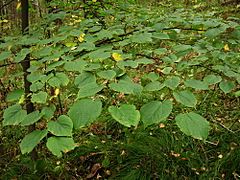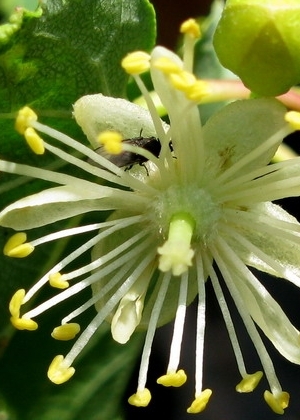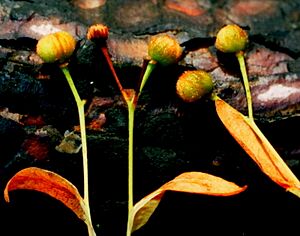Tilia nasczokinii facts for kids
Quick facts for kids Tilia nasczokinii |
|
|---|---|
 |
|
| Scientific classification | |
| Kingdom: | |
| Division: | |
| Class: | |
| Order: | |
| Family: | |
| Genus: |
|
| Species: |
Tilia nasczokinii
Stepanov
|
| Binomial name | |
| Tilia nasczokinii Stepanov
|
|
The Tilia nasczokinii is a special type of tree or shrub also known as Nasczokin's Linden or Nasczokin's Lime. It belongs to the Malvaceae family, which includes plants like mallows and hibiscus. This tree is quite rare and can only be found growing in Siberia, a large region in Russia. It prefers to live in coniferous forests, especially those with Pinus sylvestris trees. Like many trees, it is deciduous, meaning its leaves fall off in autumn. It can grow very tall, reaching up to 20 meters high!
This unique tree was named after Vladimir D. Nashchokin, a famous Russian botanist who studied plants.
What Makes This Tree Special?
Tilia nasczokinii is a fascinating plant with several interesting features. It's known as a mesophyte, which means it likes to grow in places with a moderate amount of water, not too wet and not too dry. It can also handle shady spots, so it's a shade-tolerant plant. This tree is also entomophilous, which means it relies on insects, like bees, to help it pollinate its flowers.
Leaves, Flowers, and Fruits
The leaves of the Nasczokin's Linden are shaped like a heart (cordate), or sometimes like an oval (ovate or broadly ovate). They can be quite large, usually between 5 and 15 centimeters long.
When the tree blooms, its flower clusters usually have one to three flowers. The flowers themselves are small, about 0.8 to 1 centimeter across, and are a pretty white-yellow color. If you look closely, you'll see that their stigmata (the part that receives pollen) are shaped like stars.
The ovary of the flower, which later turns into the fruit, is covered in stripes of hair. Some hairs are long, and some are short, arranged in alternating rows. When the ovary is young, these hairs are white, but as it matures, they turn a rusty color. The fruit itself is flat and round, like a small sphere.



